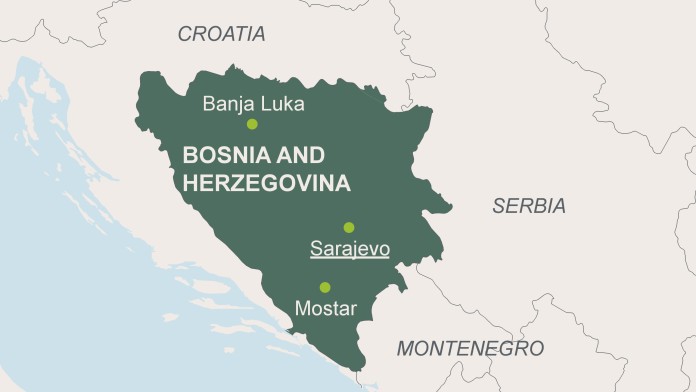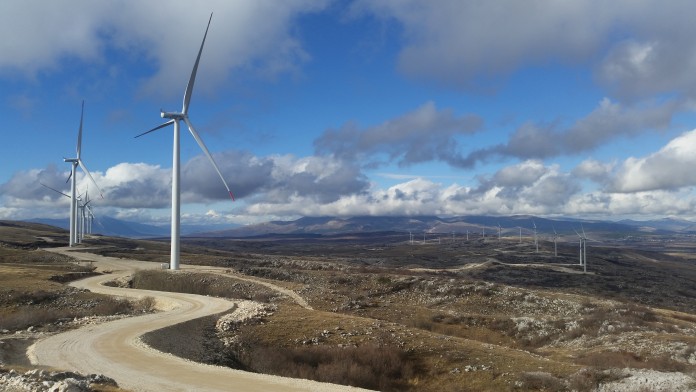
As of: 11/2022
There is a favourable wind blowing for renewable energy sources in Bosnia and Herzegovina, and it’s all down to the fact that the mountainous Karst region in southern Herzegovina offers good conditions for a wind farm. The wind whistles unimpeded over a barren lunar landscape, and nobody is disturbed by the turbines. The country aims to make use of this treasure trove – with support from KfW: The first wind farm in the country, that goes by the name of Mesihovina, was established in 2018 and is located near the city of Mostar in the southern part of the country. It is paving the way for further exploitation of wind power in the region

Wind energy is still largely untapped in Bosnia and Herzegovina, despite the country offering good conditions for it. And they are not alone. Generating energy from the air is a resource that barely registers and is still hardly exploited throughout the Balkan Peninsula. Electricity is still mostly generated using coal and hydropower. The substantial potential for generating renewable energy from the wind and sun is still largely unutilised and needs to be developed. There are reasons for this: Not only is there a lack of the necessary infrastructure for expanding the use of renewable energies, but also of the promotional conditions and financial incentives. Many companies do not have experience with the new technologies. As a result, it is still not worthwhile investing in renewable energies. However, financial support from KfW encourages interest in getting involved. Although the country has no shortage of energy (in fact, Bosnia and Herzegovina even exports electricity), there is a regional deficit. Electricity must be purchased from abroad at times when the region’s hydropower plants cannot cover the supply area's needs. In light of high and further-increasing energy prices, the energy utility company is investing in wind power as it is cheaper than imported electricity. The imported electricity is also mostly generated using lignite, and therefore contributes to climate change.
After many years of preliminary work, the wind farm was built near the village of Mesihovina about 70 kilometres west of Mostar and at an altitude of about one thousand metres above sea level. Since 2017, this site has accommodated 22 wind turbines manufactured by Siemens Gamesa with a combined installed capacity of 50.6 MW, in two rows along the ridge of a mountain. The commercial operation of the wind farm began in spring 2018. The huge turbines measure 70 metres across, but do not bother anybody on this lunar landscape. Studies conducted before building started found that neither the construction nor the operation of the wind turbines is expected to have any major impact on the environment. The project included the following individual measures: in addition to the construction site and the wind turbines themselves, each of the 22 installations received a transformer station, integrated low-voltage switchgear and control/output cables. There is also control equipment for the central control room and output cables running between the individual turbines. The project also involved procuring spare parts and special equipment, training the personnel who will be responsible for operating the facility in the future, connecting the wind farm to the main grid and building an access road. The costs for the new wind farm came to approximately EUR 80 million. EUR 71 million of this amount is being borrowed, and EUR 1 million stems from a grant for accompanying measures. The remaining EUR 8 million was contributed by the energy utility company itself.
The Mesihovina wind farm is the first of its kind in Bosnia and Herzegovina, and serves as a model for the ongoing development of climate-friendly wind power on the Balkan Peninsula. Thanks to the region’s strong winds, the 22 turbines produce around 150 GWh of power each year, an output that tends to be more typical of offshore wind farms. This can power around 33,000 homes and save 137,000 tonnes of CO2 per year. Headway was also made at the sector level: As a result of the experience with this project, the complex approval procedure of the Federation of Bosnia and Herzegovina for wind power has already been noticeably simplified. The first private wind farm has since been completed and additional wind farms are under construction or in the pipeline. KfW Development Bank has already concluded loan contracts for two further wind power projects in the country. And the wind farm is also stimulating the economy directly by opening up new business sectors and earning opportunities for local companies, be they suppliers or service providers.
The project contributes to the achievement of these following United Nations Sustainable Development Goals:
KfW Group
KfW Development Bank
Centre of Competence for Climate and Energy
KfW Sarajevo Office